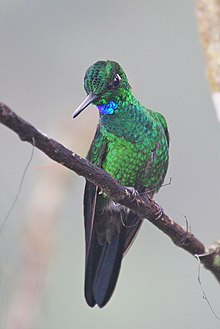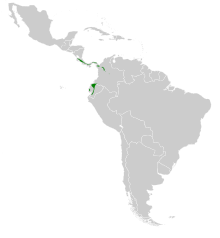Green-crowned brilliant
| Green-crowned brilliant | |
|---|---|
 |
|
| Male, NW Ecuador | |
 |
|
| Perched female | |
| Scientific classification | |
| Kingdom: | Animalia |
| Phylum: | Chordata |
| Class: | Aves |
| Order: | Apodiformes |
| Family: | Trochilidae |
| Genus: | Heliodoxa |
| Species: | H. jacula |
| Binomial name | |
|
Heliodoxa jacula (Gould, 1850) |
|
 |
|
| Range of H. jacula | |
The green-crowned brilliant (Heliodoxa jacula) is a large, robust hummingbird that is a resident breeder in the highlands from Costa Rica to western Ecuador. It is also known as the green-fronted brilliant, notably by the Handbook of the Birds of the World.
This hummingbird inhabits wet mountain forests including edges, gaps and tall second growth. It occurs typically between 700 and 2,000 m (2,300 and 6,600 ft) in altitude, mainly on the Caribbean slopes.
The nest is a bulky cup of plant fibres and scales of tree ferns saddled on a thin downsloping branch. The female alone incubates the two white 16.5 by 11 mm (0.65 by 0.43 in) eggs.
The male green-crowned brilliant is 13 cm (5.1 in) long and weighs 9.5 g (0.34 oz). It is mainly bronze-green with a glittering green crown, forehead, throat and breast. It has a white spot behind the eye, a small violet-blue throat patch, white thighs, and a deeply forked blue-black tail.
The female is 12 cm (4.7 in) long and weighs 8 g (0.28 oz). She differs from the male in that she has green-spotted white underparts, a white spot behind the eye and a white stripe below the eye, and a white-cornered shallowly-forked black tail. Young birds resemble the adult of the same sex, but are duller, bronze-tinged below and have buff throats.
The green-crowned brilliant has a loud squeaky kyew call.
This hummingbird feeds at the large inflorescences of Marcgravia vines, which the male will sometimes defend. It will also feed at Heliconia and other large flowers. Unlike many hummingbirds, the green-crowned brilliant almost always perches to feed.
...
Wikipedia

